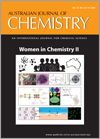
Australian Journal of Chemistry
Volume 73 Numbers 9 & 10 2020
Women in Chemistry II
This special issue of the Journal contains a collection of papers contributed by women chemists from around Australia. It showcases their achievements and recognises the broad impact women have on chemistry and its related sciences.

The Chemistry Threshold Learning Outcomes (CTLOs) have been implemented through the RACI accreditation process and indicate a shared understanding of what constitutes a chemistry degree in Australia.
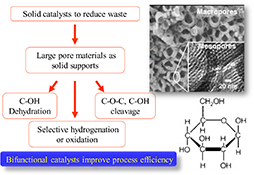
Methods to control porosity, solid acid and base character, and surface hydrophobicity are essential components of a toolkit for the design of heterogeneous catalysts for biomass processing.
CH19544Be a Catalyst for Change: Breaking Down Barriers to Maximise Australian Female Talent in Chemistry

There is a clear and growing body of evidence that indicates we are not maximising Australian female talent in the chemistry sector. This article gives an overview of the issues faced by female chemists and serves as a call to action for us all to be a catalyst for change (#catalystforchangeinchemistry).
CH19544 Abstract | CH19544 Full Text | CH19544PDF (751 KB) Open Access Article
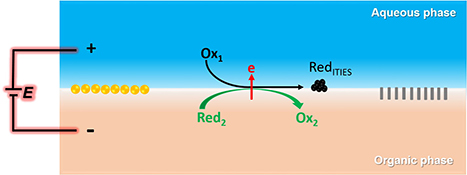
Modification of interfaces between two immiscible electrolyte solutions with nanomaterials has increasingly been applied to interfacial catalysis and analytical chemistry. Recent developments for the formation of metallic nanomaterials, carbon-based nanomaterials, and nanoporous membranes at liquid–liquid interfaces for electrochemical applications are presented.
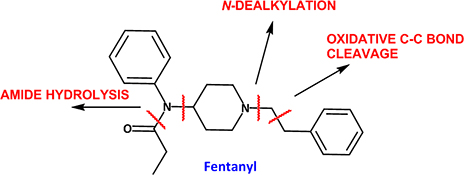
The illicit fentanyl crisis is worsening across the globe. The risk of accidental exposure to fentanyl and fentanyl analogues is a significant risk for first responders, health workers, and law enforcement. This review examines the current literature on methods of decomposition of fentanyls in operational settings and highlights the urgent need for further research.
CH19639Highlights of Radioisotope, Radiochemistry, and Radiotracer Development in Australia
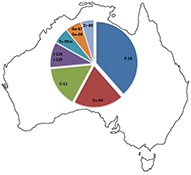
This review outlines a brief history of nuclear science in Australia, followed by highlights in radioisotope production (nuclear reactor- or cyclotron-produced), radiochemistry methodology, and radiotracer development by Australian scientists, predominantly over the past decade.
CH19398Nicotinamide-Appended Fluorophores as Fluorescent Redox Sensors

Fluorescent redox sensors are invaluable in uncovering the complex redox processes that underpin health and disease. This study investigates the use of nicotinamide, a derivative of vitamin B3, as a redox switch for the preparation of fluorescent sensors. The work identifies a new fluorescent sensor for hypoxic cells.
CH19364Developing Tamoxifen-Based Chemical Probes for Use with a Dual-Modality Fluorescence and Optical Coherence Tomography Imaging Needle
 and Rebecca O. Fuller
and Rebecca O. Fuller 
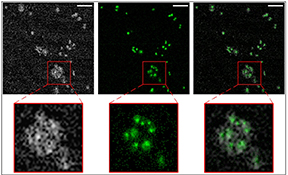
Fluorescent molecules based on the chemotherapeutic tamoxifen have been synthesised. These probes have been assessed for their use with an imaging tool being developed for the intraoperative assessment of tumour margins during breast conservation surgery. The probes are compatible with the combined optical coherence tomography-fluorescence technique.
CH19466Mixed Ramp-Gaussian Basis Sets for Core-Dependent Properties: STO-RG and STO-R2G for Li-Ne
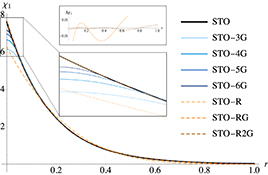
This article presents three novel mixed ramp-Gaussian basis sets – STO-R, STO-RG and STO-R2G – derived from the single zeta Slater basis set, with the aim of more accurately describing the core region. It is found that STO-RnG gives superior results to STO-(n+3)G.
CH19257The Structure of Uric Acid Dihydrate Crystals Revisited via First-Principle Methods

The formation of uric acid crystals in our body is associated with kidney stone disease and gout. The structure of one of the possible forms of such crystals, namely uric acid dihydrate (UAD), was reexamined using theoretical methods. Of the several possible orientations of uric acid molecules in the solid, one arrangement is the most stable.
CH19545Spontaneous Formation of a Hybrid Heterotrimer of Fe3O4-Ag2S-ZnS by Seeded-Growth Method
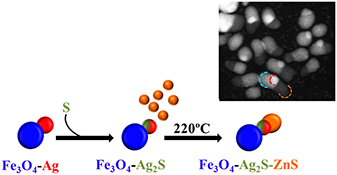
This paper describes the synthesis of heterotrimer nanoparticles through a relatively simple seeded-growth process.
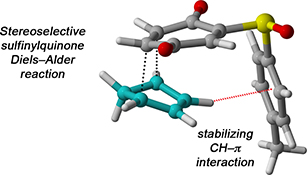
DFT calculations are reported on asymmetric Diels–Alder reactions of chiral sulfinylquinones. The origins of stereoselectivity are found to include a stabilizing CH–π interaction between the diene and the sulfinyl substituent, which favours the addition of the diene to the more crowded face of the quinone.
CH19536Diaminomaleonitrile-Functionalised Schiff Bases: Synthesis, Solvatochromism, and Lysosome-Specific Imaging

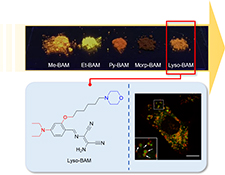
A family of diaminomaleonitrile-functionalised Schiff bases with aggregation-induced emission property were prepared. Their structure and photophysical property relationship especially in response to different solvents is discussed. The application of intracellular lysosome targeting imaging is also revealed.
CH19540Arenaran Sesquiterpenes from the Nudibranch Chromodoris strigata and its Dietary Sponge Acanthodendrilla sp. 2510: Spectroscopic and Computational Studies
 , Gregory K. Pierens, Karen L. Cheney, Anna M. Ganderton and Mary J. Garson
, Gregory K. Pierens, Karen L. Cheney, Anna M. Ganderton and Mary J. Garson 
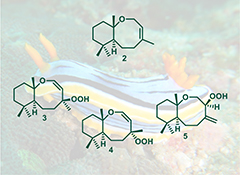
Sesquiterpenes isolated from the sponge Acanthodendrilla sp. 2510 included caparrapi oxide (1) and arenaran A (2). An extract of the nudibranch Chromodoris strigata, found feeding on the sponge, contained 2. Three additional hydroperoxides 3–5 derived from the oxocene skeleton of 2 were identified by NMR experiments, X-ray crystallography, and computational calculations. Their isolation provided insight into the reactivity of the oxocene skeleton.
CH19528Synthesis, Characterisation, and Biological Activity of the Ruthenium Complexes of the N4-Tetradentate (N4-TL), 1,6-Di(2′-pyridyl)-2,5-dimethyl-2,5-diazahexane (picenMe2)

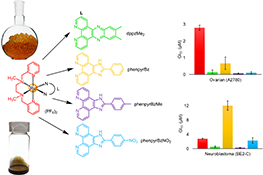
Six complexes of the type [Ru(picenMe2)(PL)]2+ (where PL = phen, dpq, dppzMe2, phenpyrBz, phenpyrBzMe, or phenpyrBzNO2) were synthesised and characterised. The in vitro cytotoxicity assays revealed that Ru-6 was 5, 10, and 40-fold more potent than oxaliplatin, cisplatin, and carboplatin, respectively.
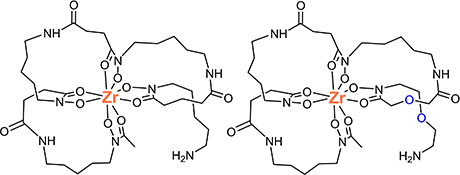
In a 1 : 1 FeIII : ZrIV competition experiment, hexadentate desferrioxamine B (DFOB) selected FeIII above ZrIV up to 48 h, with ZrIV-DFOB dominant beyond 48 h. Octadentate DFOB-PBH (DFO*), DFOB-PPH or DFOB-PPHNOCO selected ZrIV above FeIII over a 72-h time course. Excess EDTA extracted ZrIV most readily from ether-containing ZrIV-DFOB-PPHNOCO. DFOB-PPH showed favourable ZrIV-loading and trans-chelation properties.
CH19518 Abstract | CH19518 Full Text | CH19518PDF (915 KB) | CH19518Supplementary Material (1.1 MB) Open Access Article
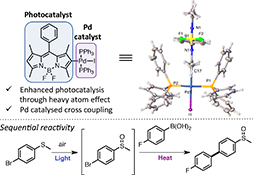
A tethered dual catalyst has been synthesised and fully characterised, where a BODIPY photocatalyst and a palladium catalyst were combined in one complex. The catalytic activity of the catalyst was investigated through both photocatalytic and transition metal catalysed reactions, demonstrating that chemical tethering enhances catalysis. The dual catalytic ability of the complex was demonstrated through stimuli controlled (heat or light) sequential reactivity.
CH19533DNA Hairpin Adsorption on Gold Surfaces: Temperature and Salt Concentration Effects on Structure
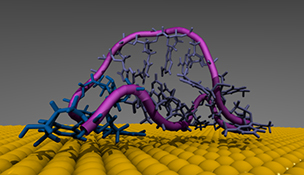
The interface between DNA and solid surfaces has wide relevance in bio-sensing applications. A deeper understanding of how common DNA motifs structurally adapt when adsorbed at sensor substrates is needed to advance these applications. Here, molecular dynamics simulations are used to predict DNA disorder due to adsorption at a gold surface, and investigate effects of temperature and salt concentration.
CH19575Electrochemical Properties of a Verdazyl Radical in Room Temperature Ionic Liquids
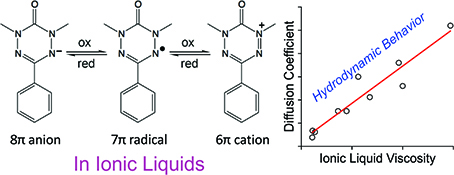
The electrochemical properties of a neutral verdazyl radical have been studied in 10 room temperature ionic liquids and propylene carbonate. Diffusion coefficients conformed to classic hydrodynamic theory; however, the reduction peak shape was significantly affected by the solvent environment. This suggests that careful choice of solvent should be considered for electrochemical studies of verdazyl species.
CH19529Operationally Simple Regioselective 5′-Phosphorylation of Unprotected 5-Ethynyl-2′-deoxyuridine Analogues
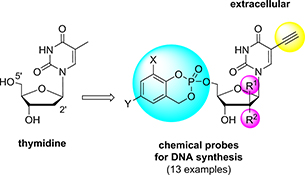
Modified nucleoside monophosphates are indispensable for drug discovery research, yet are challenging to synthesise. We have developed a straightforward method to regioselectively phosphorylate the 5′-OH group of unprotected nucleosides, overcoming some of the limitations of existing procedures for this transformation. These 5′-cyclosaligenyl phosphotriesters also have a variable 2′ substituent.
CH19531Low Temperature Synthesis of TiO2 Nanoparticles with Tuneable Phase Composition and their Photocatalytic Activity
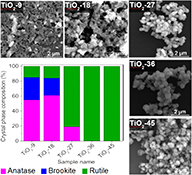
A low temperature synthesis approach with changes to the titania precursor (TiCl4) concentration was used to obtain TiO2 samples of varied phases. The photocatalytic degradation of phenol under UV irradiation was most effective when using the TiO2 sample with the highest surface area that contained anatase, brookite, and rutile phases.
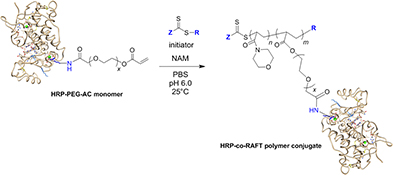
Conjugation of a polymer to a therapeutic protein is important to the biomedical industry. The preparation of protein–polymer conjugates is an expanding area, and different methods often present challenges. A technique to incorporate a protein into a growing polymer through copolymerisation is presented with full retention of the protein’s activity.
CH19514 Abstract | CH19514 Full Text | CH19514PDF (1.1 MB) Open Access Article
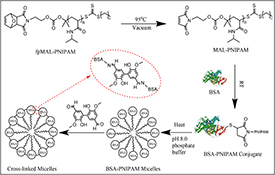
Glutaraldehyde is widely used to crosslink proteins. As glutaraldehyde is toxic, it cannot be used for drug delivery applications. Here, we explore 5,5′-bisvanillin, which was prepared by the oxidation of vanillin, as an alternative crosslinker. The non-toxic 5,5′-bisvanillin was able to crosslink nanoparticles prepared from a thermo-responsive albumin–polymer conjugate preventing disassembly.
CH19617 Abstract | CH19617 Full Text | CH19617PDF (1.7 MB) Open Access Article
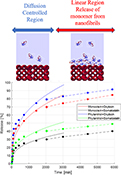
The time-dependent self-assembly of somatostatin into nanofibrils within the bicontinuous cubic phase led to a unique two-stage release mechanism, with diffusion-controlled release of the peptide monomer over the first 24 h followed by a much slower linear release of the peptide from the nanofibrils.



